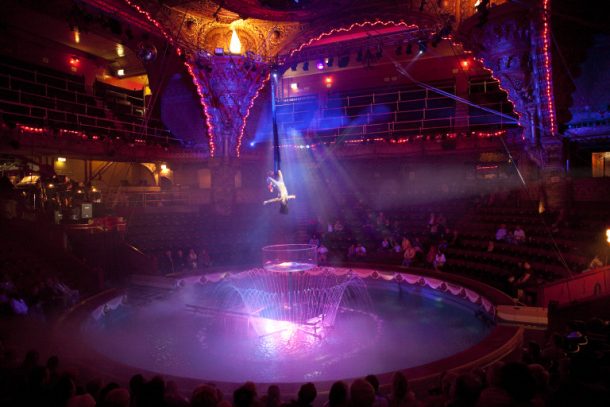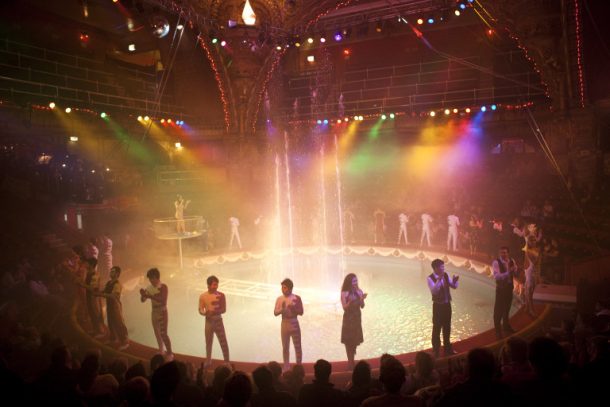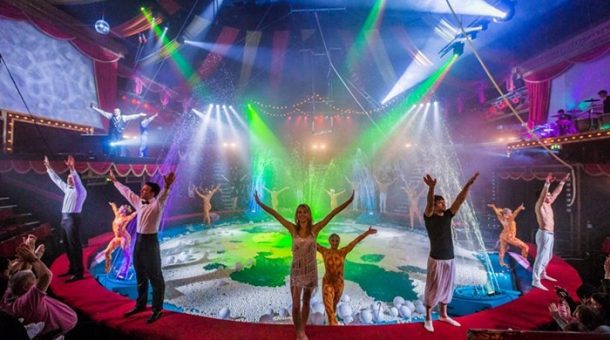In the last post of the series on the tradition of aquatic circus, Curator Cathy Haill looks at the water spectacles in modern circus.
When architect Frank Matcham designed the interior of the London Hippodrome he was not without experience of a similar project. He had recently worked on the re-design of the interior of the Blackpool Tower Circus where an aquatic circus finale with dramatic lighting can be seen today. The sight of a circus ring filling with jets of water is still amazing, and makes you appreciate the wonder of Victorian and Edwardian audiences who sat like you within Matcham’s fantastically decorated Moorish interior that opened to the public in June 1900.

Gustave Eiffel’s wrought iron tower stunned Paris when it was built for the Great Paris Exhibition of 1889. It also inspired the Blackpool hotelier and Mayor John Bickerstaffe to recreate a smaller replica on the seafront of his home town, designed by architects James Maxwell and Charles Tuke on the site of an aquarium. The Blackpool Tower Company, registered in 1891, spent three years and £290,000 on its construction, and opened to crowds of curious visitors on 14th May 1894. Unlike the Parisian tower it was not freestanding. Its base housed The Tower Aquatic and Variety Circus featuring a hydraulically operated ring that sank to a depth of six feet and contained 42,000 gallons of water, modelled on Joseph Oller’s ring in the Nouveau Cirque that opened in Paris in 1886.
Blackpool Tower’s first circus programme of 1894 lists ‘exhibitions of scientific swimming’ by Professor J. Finney, Miss Marie Finney and the Sisters Johnson, followed by ‘the most magnificent water pantomime’ Undine, or the Water Fairies Ballet produced by Professor J. Finney, featuring Maud Finney as the Queen of the Water Fairies. There were traditional circus acts in the ring including Professor Nero and his Four Wonderful Performing Bulls, Herr Herkenrath and his celebrated Elephant and Pony Act and the Phoite Pinaud troupe of Fantastic Pantomimists and Masqueraders, but fittingly for a seaside town the emphasis was more upon aquatic spectacle. In 1897 the circus celebrated Queen Victoria’s Diamond Jubilee with its ‘gorgeous electric water effect’ of ‘Diamond Jubilee Rainfall’, followed by swimming demonstrations and a dive by Marie Finnie, apparently ‘from a height of sixty feet into the water’ that seems hard to achieve safely into six feet of water! Queen Victoria loved circus, but although she invited Charles Sanger’s company to Windsor, she never visited the circus after Prince Albert’s death in 1861. How she would have loved that Diamond Jubilee Rainfall!

Blackpool’s early aquatic spectacles included On The River in 1899, and The Stag Hunt, a water pantomime featuring deer, wild boar, stag hounds and horses plunging into the water. By the 1930s however the lavishness and creativity of water spectacles directed by Clement Butson reached new heights, as for their 1936 production based on the Arabian Nights.

Great Yarmouth Circus is the only other circus in Great Britain staging water spectacle, thanks to its present owner Peter Jay who lovingly restored the sinking ring to working order in 1981 after twenty-five years’ disuse. Unlike Blackpool’s Tower Circus that nestles within the tower and shares its home with the Tower Ballroom, Great Yarmouth is the only purpose-built circus building in the country. Opened in July 1903 and staging some of the aquatic spectacles seen at the London Hippodrome including Tally-Ho! in 1904, it was built by the circus showman George Gilbert to the designs of the local architect Ralph Scott Cockrill. Designated today as a building of ‘outstanding importance’, its entrance decorated with Art Nouveau motifs leads into the tiled entrance and box office. Being within the original 1903 building and seeing the sinking ring flooding for aquatic spectacle that lasts for the entire second act is an unforgettable and magical experience – a time machine with modern lighting that links you to the past and has to be seen to be believed.
To find out more about the V&A Collections visit Search the Collections and Search the Archives.


